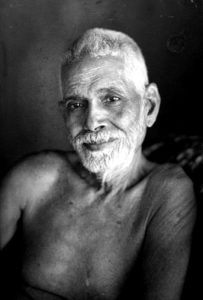“Who am I?”
This question has haunted thinkers and philosophers from the earliest times. It is the question that drove the sixteen-year-old Venkataraman to eventually become Ramana Maharishi. It is the question that pops up every now and then, only to remain unanswered. Once it is answered, the question never recurs, for one would have transcended all questions by answering that one.
So, who are we?
From our high school biology we know that when a sperm fertilizes an oocyte, the single-cell zygote is formed. Then the embryo comes into being, finally developing into the foetus. All this while, the newborn draws nourishment from the mother. The various foods that she consumes are also sucked in by the newborn. Thus by drawing from various material resources, the infant grow physically. Genes are passed on to the child from both the father and the mother, who are themselves carrying long-forgotten messages from several generations in the mystical lines of their genetic code.
From the time of our birth in this world, we constantly observe the world around us through our various senses, gathering data of all kinds. We learn language from our parents and our immediate surroundings. Our natural temperament, which is decided by our DNA, slowly begins to manifest as we grow up. As our language learning increases, we begin to absorb information by means of language – be it by reading books, listening to people, or by watching videos. (It is still debated whether we can have cognition without the medium of a language.) We begin to create things of our own – be it new words and sentences, or various new actions using our limbs, or structures from mud and clay.
Now amidst all this ceaseless action that starts even before the umbilical cord is severed, where do we find our true self? We know that our body is what it is because of all the nourishment it has drawn from the material world. Our innate talents and temperament are also not something that we can call our own – we owe it largely to our genes. The many years of schooling and learning, the many books and movies we consume, the many discussions we have with wise men and women – all these contribute to our thought process. The knowledge we have is acquired. And what we consider to be original, creative thought is just “combinatory play,” as Albert Einstein termed it. We’re merely juxtaposing pieces of learnt information and “creating” something new but in truth, it’s just clever re-arrangement, albeit unconscious.
Ramana Maharishi often emphasized the process of finding our true selves. He would often urge his disciples to pose the straightforward but extremely difficult question: “Who am I?” He would ask his disciples to meditate on the Self if they wished to know the highest reality. We know what we exist – we feel our existence at all times. There is no need for any external validation for that. But who is the one who we feel exists? What is this ‘I’ made up of? How to describe it? What are its attributes?
This question takes us deep into our quest for identity. What truly identifies us? We often look to external, ephemeral attributes as identifiers – I am dark, I am tall, I am overweight, I am Japanese, I am a Sikh, I am an IAS officer, I am a woman, I am intelligent, I am a Yadav, I am rich, I live in Paris, I am vegetarian, I wear clothes, I drink rum, etc. But our true self is beyond these external identities. When we are in a state of deep sleep, none of these attributes matter. Yet everyone knows that it is we who are asleep. We wake up as the same person. There seems to be an unbroken link of self-awareness.
Even if we lose our memory, our identity remains. Those who know us still recognize us. And how does this process of recognition happen? Is it merely by looking at one’s face? It’s possible that two people look alike. Is it their body structure? Identical twins are often similar in height and weight. Is it their voice? Or their habits? Their mannerisms? All these can be replicated. In fact, when skilled actors act in biopics, they practically become the character they are playing. For instance, Morgan Freeman spent months observing every small trait of Nelson Mandela while portraying him in the movie Invictus. Also, there are times when you see someone, hear their voice, observe their actions and still feel unsure about their identity – perhaps driven by a gut feeling that there’s something different. Either the person is out of sorts or this is not the same person at all. What really tells you this?
In the Bhagavad-Gita, Krishna says that adhyatma is the essence of one’s unique qualities; it is an individual’s real identity (BG 8.3). But even this “essence of one’s own qualities” seems to be acquired from multiple sources. Every person is a repository of the collective consciousness and wisdom of the people whom she has interacted with – either directly or indirectly. At every step, we are assisted by other humans and by nature. Whether it is in the procurement of food, the stitching of clothes, or the building of houses, we depend on hundreds and thousands of people. And in turn, we help in constructing the identities of hundreds and thousands. Where amidst all this harmony is the space for the single note of individualism? What really makes an individual? When there seems to be nothing truly belonging to a single person and practically every aspect being a result of the toil of many others, can we even define an individual in practical, realistic terms? Or is it just an illusion? Yet, each and every one of us feels our own existence. Our uniqueness. Our ego.
What then is the truth? It is of course for each one of us to figure it out. And when we do, we will be satisfied within the true Self, like Krishna says – "आत्मन्येवात्मना तुष्टः" – in the Gita.
An earlier version of this article was first published in Daily O as part of my column Commonsense Karma.
















































